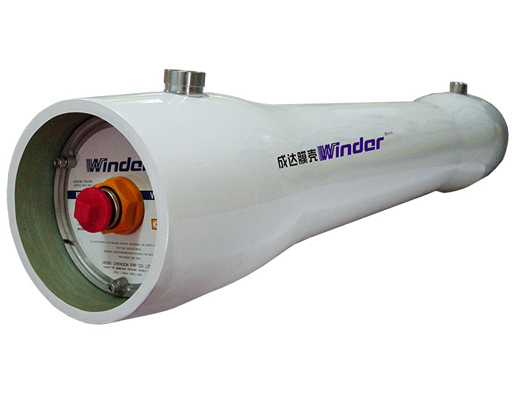The main causes of reverse osmosis membrane pollution include physical pollution, chemical pollution, and organic pollution.
Physical pollution is metal (such as metal oxides such as iron and manganese), non-metals (such as less soluble non-metal salts such as CaCO3, CaSO4, BaSO4), colloidal pollutants (such as dioxide Silicon, etc.) on the surface of the film, blocking the film pores;
Chemical pollution refers to harmful chemical components adsorbed in the pores of the membrane;
Organic pollutants are contaminations formed by bacterial slime, fungi, mold, organic matter, etc. adhered to the membrane surface and within the membrane pores.
Flux attenuation and reduction of separation ability caused by the adsorption of pollutants, especially organic substances, on the membrane surface and in the membrane pores of the substances that can cause pollution of reverse osmosis membranes are the main reasons for membrane flux attenuation. However, the flux attenuation caused by membrane fouling is often mixed with the reversible flux decrease caused by the concentration polarization phenomenon, which further reduces the membrane separation effect.
1. Organic pollution
Organic pollution is currently the most difficult problem in the reverse osmosis industry. Organic matter contained in raw water or improper application of organic agents in the pretreatment system can cause membrane fouling. Reverse osmosis membranes are organic materials that can cause the growth and reproduction of bacteria, viruses, and algae. The presence of more organic substances (BOD5) in the reverse osmosis water will also promote the growth of microorganisms; if an excessive amount of organic scale inhibitors such as phosphorus are added to the water, and the temperature of the reverse osmosis feed water is suitable, it will promote rapid growth of microorganisms.
Microorganisms include bacteria, algae, fungi and their spores, spores and viruses. Bacteria particles are extremely small, generally 1 ~ 3 μm, and viruses are even smaller, about 0.01 ~ 0.2 μm. Algae and fungi are much larger than bacteria. The number of bacteria is usually very large. When there is more than one drop of water, it can contain tens of millions, and in rare cases, it can contain several or dozens of them.
Surface water contains many microorganisms. In recent years, examples of bacteria multiplying and polluting water quality have been found in groundwater. Microorganisms can be regarded as colloids with negative charges. Most of them can be removed by coagulation and filtration, but complete removal is very difficult and complicated. Although chlorination disinfection and oxidation are used, there will still be a small number of them, even in the form of spores. Concealed temporarily.
When a large number of vigorous microorganisms are bred on the surface of the membrane, the microorganisms covering the membrane surface and the mucus produced by the membrane will not only block the membrane pores, reduce the membrane's desalination capacity, increase the pressure difference during the operation of the membrane, and reduce the water production; It also destroys the desalination layer of the reverse osmosis membrane, which is irreversible.
2. Colloid pollution (physical)
Colloidal pollution is one of the important factors for fouling of reverse osmosis membranes. Colloids are particles of inorganic or organic and inorganic mixtures suspended in water. It does not precipitate by its own gravity. Colloids usually contain one or more of the following major components: bacteria, sulfides, clays, colloidal silicon, Al3 +, iron corrosion or organics, and the like.

Reverse Osmosis Membrane Pressure Vessels
3. Ion scaling
During the reverse osmosis operation, the concentration of solutes on the surface of the membrane increases rapidly due to the concentration polarization, and the substances that are not easy to dissolve and precipitate or have a small solubility product will accumulate on the surface of the membrane due to the concentration polarization and precipitate the knots. Scale, which causes the fluid resistance in the boundary layer to increase (or increase the local osmotic pressure), which leads to a decrease in the driving force for mass transfer. Concentrations exceed their solubility and precipitate out, producing deposits and staying on the membrane surface and in the membrane pores to form scale, which pollutes the membrane, causing the water permeability of the reverse osmosis device to decrease, the pressure difference to rise significantly, and the efficiency to decrease rapidly.
Membrane fouling is generally formed by a mixture of ionic fouling, colloid fouling, and organic fouling, which makes the membrane separation effect further reduced and difficult to recover.
4. Fouling of reverse osmosis membrane formed by improper operation
Reverse osmosis membrane pressure vessels were rapidly depressurized during shutdown without being thoroughly flushed with reverse osmosis water. Since the concentration of the inorganic salt on the thick water side of the membrane is higher than that of the raw water, the incomplete flushing after shutdown will cause pollutants to quickly deposit on the membrane surface, resulting in fouling and fouling the membrane.
5.Pre-processing system failure
Reverse osmosis membrane housings When the feedwater pretreatment system is short-circuited or malfunctions, it loses or partially loses its processing function. The feedwater contains a large amount of suspended particles and colloids. Far beyond the scope of reverse osmosis feedwater quality standards, causing suspended particles and colloids to form amorphous precipitates on the membrane surface, blocking the water inlet channel of the reverse osmosis membrane and contaminating the membrane.
Our company provides precision filter housing. If you have any needs for our products, please feel free to contact us.